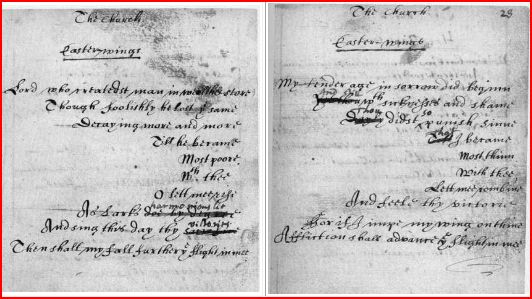Easter Wings
The same poem turned about on itself
forms a pair of wings
The poem is usually printed in modern anthologies as seen above. In the 1633 edition. the poem is printed as seen in the scanned copy below, making it look more like its title.
For a different placement here are copies of the Williams Manuscript
(also called MS. Jones B 62 in Dr. Williams Library)
The Bodleian MS (also called MS Tanner)
page 1 of "Easter-wings"
~ ~ ~ ~ ~ ~ ~ ~ ~ ~ ~ ~

Bringing Christian classic books to life
George Herbert, The Temple - http://www.ccel.org/h/herbert/temple/TempleFrames.html
George Herbert, The Priest to the Temple - http://www.ccel.org/ccel/herbert?show=worksBy
George Herbert - (1593-1633), Poet and divine
George Herbert was born to a noble family in Wales; his mother was patron to John Donne who dedicated his 'Holy Sonnets' to her. He was educated at Westminster School and Trinity College, Cambridge, where in 1620 he was elected to the prestigious post of Public Orator.
His first two sonnets were sent to his mother in 1610. On the theme that the love of God is a worthier subject for verse than the love of woman. They foreshadowed his future religious and poetic inclinations, but at first Herbert seemed bent on a secular career, much involved in court life and Member of Parliament for Montgomery in Wales from 1624-5. His only published verse during this period was in Greek and Latin, for formal occasions.
In 1627, however, he resigned as Orator and was ordained a priest, becoming rector at Bemerton in Wiltshire where he was noted for his diligence and humility, traits reflected in his poetry which also expresses the conflict between the religious and worldly life.
When he realized he was dying of consumption, he sent a collection of his poems in manuscript to his friend Nicholas Ferrar to judge whether to burn them or publish them. The result was The Temple, religious poems using common language and rhythms of speech, published to enormous popular acclaim and running to 13 editions by 1680.
Also published after his death, in 1652, was A Priest to the Temple: Or the Country Parson, his Character and Rule of Life homely, prose advice to country clerics.
~ ~ ~ ~ ~ ~ ~ ~ ~ ~ ~ ~
Related Criticism to Herbert's poem, "Easter Wings"
http://www.ccel.org/h/herbert/temple/Easterwings.html Joseph Addison, in The Spectator, No. 58, Monday, May 7, 1711, argued against ancient Greek poems in the shape of eggs, &c. as false wit. He continued:
Professor's rebuttal (without degrading Addison's perception or gift for expression):
When devices are dropped into/on to a work, they are just ornaments scattered on pseudo-art/kitsch (in this Addison rings true). When ornaments are integrated into the meaning of the work, they loose their ornamentation and become part of the meaning, working together in the poem. Herbert converted the use of popular devices and tricks of his day into his vision of the world, giving an understanding beyond the mundane. [In a similar way that God takes clay and makes something better out of it.] (JRA)
Art Student's Addenda:
This is the difference between Baroque and Classical Art. Baroque art is famous for its ornaments, but details support the concept of the work in Classical Art.
Music Student's Coda:
The history of music classes Bach as baroque, but his "ornaments" advance and echo the message of the piece and hold the entire work together. As Albert Schweitzer shows concerning the Preludes for Organ. In this way Bach was closer to the Classic Period than most give him credit.
|
Vocal arrangement of Easter Wings (White, Medium-high voice and piano, 430-411 For Sale.) Background: song of a true lark Optional music: Welsh folksong "Rising of the Lark" arranged by Red Dragon |





